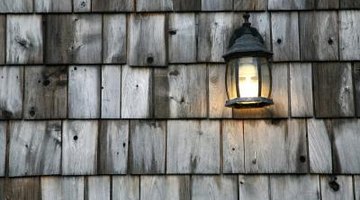Can I Install Vinyl Siding Over Cedar Shingles?
Walls protected with cedar shingles need refitting before installing vinyl siding, but the cedar shingles can stay in place. Building codes require continuous weatherproof sheathing beneath vinyl siding, and a shingled wall does not satisfy that requirement. Any existing moisture problems need correction before installing new siding. Siding can trap moisture and increase mold and wood rot in a damaged wall.
Shingled Walls

The outer section of a cedar-shake wall begins with a layer of wood planks or plywood paneling nailed over the building's framing. Tar paper or a similar weather-resistant fabric covers the paneling, and cedar shingles in overlapping rows make up the outer surface. Shingles deteriorate if the wall collects moisture, so many shingled walls use furring strips nailed horizontally over the tar paper to ensure the shingles don't trap water. A shingled wall in good condition can stay in place under vinyl siding. Nail down any loose shingles, and pull out and replace any cedar shingles showing signs of rot.
Furring
To create the best weatherproofing, vinyl siding needs a flat surface for a base. Vinyl expands and contracts as it heats and cools, moving much more than underlying wood. Seasonal temperature differences can cause 1/2 inch of movement in a vinyl panel 12 feet 6 inches long, according to the Vinyl Siding Institute. If installed over an uneven surface, vinyl siding can jam and buckle because of temperature changes. Nailing 1-inch by 2-inch furring strips over a shingled wall establishes a level base for the new siding. Shims placed underneath furring strips can even out an irregular shingled wall.
Paneling
Rigid foam panels nailed to the furring strips provide a solid, insulating backing for vinyl siding. Other options for this layer include plywood and oriented-strand board, a composite panel made from wood fiber. Building codes require a water-resistant barrier between the backing panels and the siding. Vinyl siding deflects most water, but intentional ventilation between the siding strips can let some water through. The continuous water-resistant layer laid over the backing panels could be asphalt felt, plastic house-wrap or a liquid waterproofing applied to the foam backing panel. Local building codes might demand specific materials for this water-resistant layer.
Flashing
The water-resistant barrier includes metal flashing strips around all openings in the wall, such as windows and doors. Flashing also protects seams wherever the vinyl siding connects to other surfaces such as stucco or brick. Before installing flashing, scrape out all old caulking and re-caulk any gaps. Flashing edges embedded in a bead of sealant and nailed to the backing panel with compatible nails effectively weatherproof wall openings. Any corrosion-resistant fastener such as aluminum or galvanized nails can hold vinyl siding in place, but only aluminum nails or stainless steel fasteners hold aluminum trim without corroding.
References
Resources
Writer Bio
James Young began writing in 1969 as a military journalist combat correspondent in Vietnam. Young's articles have been published in "Tai Chi Magazine," "Seattle Post-Intelligencer," Sonar 4 ezine, "Stars & Stripes" and "Fine Woodworking." He has worked as a foundryman, woodturner, electronics technician, herb farmer and woodcarver. Young graduated from North Seattle Community College with an associate degree in applied science and electronic technology.
Photo Credits
- Jupiterimages/Photos.com/Getty Images
More Articles



